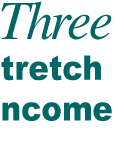|
 So far, we’ve offered suggestions to increase your retirement nest egg by increasing savings, increasing household income, reducing debt and spending, taking advantage of income tax breaks, and investing wisely through diversification and dollar-cost averaging. This section describes six other ways to catch up financially by making various lifestyle decisions such as how long you work, where you choose to live, and how you tap your assets for retirement income. So far, we’ve offered suggestions to increase your retirement nest egg by increasing savings, increasing household income, reducing debt and spending, taking advantage of income tax breaks, and investing wisely through diversification and dollar-cost averaging. This section describes six other ways to catch up financially by making various lifestyle decisions such as how long you work, where you choose to live, and how you tap your assets for retirement income.
Trade Down to a Smaller Home
Your choice of retirement housing can greatly affect the amount you need to save for retirement. Trading down to a smaller home, say from a $200,000 four-bedroom home to a $90,000 two-bedroom condo, can be a very effective catch-up strategy. Benefits of trading down include:
- Proceeds from the sale (minus sales and moving expenses and the cost of a new home) are available to invest for future income.
- Maintenance costs, property taxes, and utilities on a smaller property are generally lower.
- May provide an opportunity to live in your current community, but at a reduced cost.
Thanks to 1997 tax law changes, you no longer need to consider age requirements before trading down. In addition, generous capital gains tax exclusions apply — $250,000 for single taxpayers and $500,000 for couples filing jointly — so most people won’t owe taxes on the sale of their home.
Table 11 indicates the amount of income that could be available from varying levels of home sale profit, assuming a 7% annual return, exclusive of taxes and inflation. Of course, actual investment returns will vary with market conditions and fluctuate over time. Thus, it is wise to set aside a portion of investment earnings from years with high market returns to provide additional income during years when investment performance is below expectations.
Table 11
Annual Income from Different Levels of Home Sale Profit
|
Amount of Home Sale Profit
|
Annual Income (Average Return of 7%)
|
|
$25,000
|
$1,750
|
|
$50,000
|
$3,500
|
|
$75,000
|
$5,250
|
|
$100,000
|
$7,000
|
|
$200,000
|
$14,000
|
|
$300,000
|
$21,000
|
|
$400,000
|
$28,000
|
|
$500,000
|
$35,000
|
Case Study
Celia and Jack Doering, 52 and 54, recently sold their four-bedroom home and netted $240,000 after sales expenses. They then bought a two-bedroom townhouse five miles from their previous home for $120,000. The Doerings expect their monthly housing costs to decrease by almost $400 with reduced property taxes, utility bills, and maintenance. With their home sale profit, the couple invested $60,000 in a stock index fund for long-term growth and are investing $10,000 a month over six months into a “laddered” portfolio of Treasury notes to provide monthly income. (In a laddered portfolio, the investments have different maturity dates.) They expect an average annual return of 7% on their home sale profit, or about $8,400 annually without spending the principal.
Worksheet 7: Proceeds from the Sale of My House
Resources
- For a professional estimate of the value of your home, contact a local real estate agent. The service is generally free because real estate agents hope you’ll contact them when you’re ready to sell.
- To compare expenses for different housing decisions, visit the Purdue University “Planning for a Secure Retirement” Web site at www.ces.purdue.edu/retirement/Module2/module2.html
Move to a Less Expensive Location
Another way to reduce living costs is to move to a less expensive location in the United States or even abroad. If you currently live in a high-cost area such as the Northeast or West Coast, retiring to a state in the South or Midwest is likely to reduce your living expenses. This way, you may be able to acquire similar square footage at a reduced cost—and not have to sell a lot of possessions to downsize.
As with the trade-down strategy described previously, the difference between the sales price of your current home and the cost of a house in a less expensive area can be invested to produce income (see Table 11 and Worksheet 7). Ongoing state income taxes and property taxes may also be lower. A major trade-off, however, may be less proximity to family, friends, and community. Many families find it difficult to pull up roots and start over in a new location. Not surprisingly, fewer than 5% of Americans age 65 or older have moved in recent years, according to the U.S. Census Bureau.
If you are considering an out-of-state move to reduce living costs, make plans before you retire. Visit potential retirement spots on vacations and subscribe to their newspapers. Get a feel for the community you are considering. Inquire about medical facilities, cultural and entertainment attractions, weather, employment opportunities, and other issues of concern. Consider renting in a new area, instead of purchasing a home right away, in case you change your mind or find a better place to live. Also, factor in the cost of travel expenses to visit family and friends and the potential need for paid caregivers as you age, if a family support network won’t be nearby.
Case Study
George Omos, 64, is a widower. He recently retired from a sales position in New York City and is selling his $350,000 home in New Jersey. He hates the winter snow and is looking forward to warm weather year-round. Omos is moving to a $170,000 townhouse in a retirement community near Tampa, Fla. The townhouse is close to where his sister and 92-year-old mother currently reside. He plans to work 15 hours a week in a side business and get involved in activities at the community clubhouse. After moving and sales expenses, Omos expects to clear $150,000, which he will invest in equal amounts in a stock index fund and a bond index fund. He expects his investments to average an 8% annual return, which will produce about $12,000 of annual income to supplement his Social Security and company pension.
Worksheet 8: Retirement Relocation Analysis
Resources
- Visit “The Salary Calculator” at www.homefair.com/homefair/calc/salcalc.html?type=to to compare living costs between different locations. The calculator will tell you how much income you’ll need in a new location to match the lifestyle possible in your present location.
- The Late-Start Investor by John F. Wasik (1998, Owl Books). Chapter Three provides an overview of the impact of lifestyle decisions on the amount of income that a retiree needs.
Delay Retirement
 Continuing to work—even for just a few more years—provides additional income to invest in tax-deferred plans. Working may also postpone asset withdrawals, allowing funds to grow with compound interest. In addition, workers participating in defined benefit pension plans (pensions that pay benefits based on income and years of service) may be able to increase their benefits by remaining on the job longer. Social Security payments may also increase with additional years of earnings. Continuing to work—even for just a few more years—provides additional income to invest in tax-deferred plans. Working may also postpone asset withdrawals, allowing funds to grow with compound interest. In addition, workers participating in defined benefit pension plans (pensions that pay benefits based on income and years of service) may be able to increase their benefits by remaining on the job longer. Social Security payments may also increase with additional years of earnings.
The longer you remain in the workforce, the less you will need to save for retirement. Letting existing investments grow for a few extra years can make a tremendous difference in the amount of annual savings required (as shown in Figure 1). The analysis assumes a current age of 45, withdrawals of $20,000 per year from savings during retirement, 3.5% inflation, an 8.5% average annual return, and average life expectancy based on U.S. Census Bureau data.
Figure 1: Annual Savings Required to Provide $20,000 of Retirement Income Starting at Ages 62 to 68

For example, if you plan to retire at age 62, you must begin saving $13,469 per year at age 45 to be able to afford $20,000 annual withdrawals after retirement. If you plan to wait until age 68 to retire, you would only have to save $7,701 per year to meet your retirement withdrawal goal of $20,000 annually.
Note the difference in savings required annually for retirement at age 62 versus at age 68. Delaying retirement for six years means a difference of saving $5,768 per year ($13,469 minus $7,701). Of course, the trade-off for delaying retirement is less control over the use of your time and the daily hassles of working. Some employers allow workers to phase in their retirement—working three days per week instead of five, for example — to provide flexibility for both parties and to make use of experienced employees’ knowledge and skills. If you’re considering this, check whether pension benefits will be negatively affected.
Delaying retirement is especially attractive during extended market downturns such as the early 2000s. If you’re still working, you don’t need to withdraw money from assets when prices are depressed. A good way for retirees to avoid this predicament is to keep at least five years worth of annual cash withdrawals in liquid savings products (such as a money market mutual fund) to ride out market volatility.
Case Study
Fred Wescott, 48, is single and getting a late start saving for retirement. He planned to retire at 56 until he did a retirement savings calculation and realized he could not afford to replace even 60% of his preretirement earnings. Fred checked several retirement calculators and learned he could afford to retire comfortably if he waited until age 64. In his analyses, he assumed higher pension and Social Security benefits for working eight additional years. By remaining in the workforce longer and receiving employer benefits, Fred also will not have to purchase an individual health insurance policy to carry him through until he is eligible for Medicare.
Worksheet 9: Retirement: Early vs. Later?
Resources
- Check the online Retirement Readiness Quiz to measure how well you are preparing for retirement. Users answer a series of 12 questions and receive a score ranging from 0 to 25, with a score of 25 indicating the best job of preparation. The Web site address is www.asec.org/rrr.htm.
- Check the “Social Security Benefits Planner” and “Retirement Age” calculators on the Planning For A Secure Retirement Web site at www.ces.purdue.edu/retirement/Module3/module3.html. The calculators provide estimates of future Social Security benefits and show what happens to Social Security benefits if you retire early or delay retirement.
Work After Retirement
An additional catch-up strategy is to semiretire—continuing to work two or three days per week or starting a home-based business. In addition to providing income, work after retirement can provide a sense of fulfillment, social contact, and a daily routine.
The major financial benefit of semiretirement is that it reduces the amount of money you need to withdraw from investments to supplement Social Security and/or a pension. This stretches your retirement assets, a tremendous advantage for late savers. Two possible disadvantages are Social Security earnings limits for beneficiaries ages 62 to 64 and taxation of Social Security benefits at certain levels of household income.
Assume someone is 65 and about to retire and start collecting Social Security. This person has saved $100,000, needs $24,000 a year to live on (80% of a $30,000 preretirement income), and will receive $12,000 from a small pension and Social Security. This means the retiree will need $12,000 from retirement savings each year.
One option is to withdraw the entire amount (that is, $12,000 annually) for as long as it lasts. A much safer option is to withdraw, say, a third ($4,000) of this amount and make up the remaining $8,000 from self-employment. A $4,000 withdrawal, in this example, represents 4% of the $100,000 nest egg. If the semiretired worker earns a higher rate of return than 4%, the account balance will continue to grow and provide a cushion against inflation.
If $12,000 withdrawals are made, however, a nonworking retiree will have less than $20,000 by age 75. He or she would be in great danger of outliving investments and having to live a drastically reduced lifestyle. A number of recent studies, using both historical and hypothetical investment returns, suggest that retirees should not withdraw more than 4% to 4.5% of their portfolio annually to avoid prematurely depleting their assets. One study found that, assuming a portfolio with 50% or more in stock and a withdrawal rate of 4%, there has never been a 25-year period since 1925 when an investor would have run out of money.
Work is an important part of many baby boomers’ lives and many look at retirement as a way to improve work-life balance, but not to discontinue working entirely.Post-retirement work options include working for your current employer at a reduced schedule (phased retirement), freelancing for a current employer, working at a "bridge job" or business before retirement and continuing to work at it after retirement, working for a new employer, working for a temporary employment agency, working for yourself, or starting a small business.
Worksheet 10: Post-Retirement Employment Assessment
Resources
- The Retirement Catch-Up Guide by Ellen Hoffman (2000, Newmarket Press). Chapter 3 provides information about starting a new business and phasing in retirement.
- Get out a calculator and calculate how much money you don’t need to save by working part-time during retirement. For example, assuming a 7% average annual return, $14,000 of earnings from paid employment is equivalent to not having to withdraw interest earned on $200,000 of savings ($200,000 x .07 = $14,000).
Reverse Mortgages and Sale-Leaseback Arrangements
Reverse mortgages and sale-leaseback arrangements are catch-up strategies for retirees who are “house rich and cash poor.” They can help late savers convert their home equity into spendable cash without having to move.
Reverse Mortgages
Reverse mortgages are available to homeowners who are age 62 and older and own their homes free and clear. Borrowers receive a lump sum, monthly payments, or a line of credit based on three factors: age of the younger homeowner, amount of home equity, and current interest rates. Reverse mortgages are repaid from the borrower’s equity after a fixed period or when they move out of the home, sell it, or die. Interest accrues on the loan until it is repaid. If the house is sold for less than the loan amount, the lender absorbs the loss. The downside of reverse mortgages is that they are complicated and interest rates and fees are much higher than for regular mortgages (see Table 12).
Table 12
Advantages and Disadvantages of Reverse Mortgages
|
Advantages of
Reverse Mortgages
|
Disadvantages of
Reverse Mortgages
|
- Borrowers can remain in their home for as long as desired.
|
- Loan origination fees and closing costs are often several thousand dollars up front.
|
- Payments are tax free. Social Security and Medicare are not affected and payments do not affect SSI or Medicaid as long as money from the loan is spent within the month it is received.
|
- On an annual basis, loans are very expensive if the homeowners die or move out of their house soon after taking out the loan.
|
- No regular income is necessary to qualify for the loan, only proof of property ownership and home equity
|
- Cash payments from a reverse mortgage are usually lower than income from an annuity you might purchase if you sold your home and invested the proceeds.
|
- Money from a reverse mortgage can be spent for any purpose, such as medical care, property taxes, and home improvements. There is generally a choice of payment options (for example, lump sum, fixed monthly amount, or line of credit).
|
- A reduced amount of home equity is available to distribute to one’s heirs as an inheritance.
|
Sale-Leaseback Arrangements
With sale-leaseback arrangements, homeowners of any age sell their home, typically to a close family member, and then lease it back. The proceeds from the sale of the home are available to invest without the necessity of moving or paying real estate commissions. The new owner receives the tax advantages associated with a rental property and the former homeowner, turned renter, gets to stay in the home they love, but have difficulty affording.
Because sale-leaseback involves a contract between two parties, consult an attorney to draw up the paperwork. This is especially important when the parties are related—so everyone is clear as to what is expected and there is a basis for legal recourse, if necessary. Also, be sure to solicit solid tax advice because the IRS examines these transactions closely and expects to see market-based interest rates and rental payments.
Case Study
Nelson and Lucy Chang, 66 and 70, are considering a reverse mortgage to provide additional monthly income to travel and maintain their $150,000 home. They are not concerned about inheritance issues because their two children, 38 and 44, have good jobs and are financially self-sufficient. They visited a Web site run by the National Center for Home Equity Conversion, and learned they could get a credit line of almost $70,000 (or monthly payments of $450) for as long as they live in their home. To decide if a reverse mortgage is right for them, they plan to compare at least three different lenders and they have scheduled a free counseling session with a counseling agency approved by the Department of Housing and Urban Development (HUD).
Worksheet 11: Reverse Mortgage Comparison Worksheet
Resources
- The National Center for Home Equity Conversion Web site has a calculator that estimates reverse mortgage loan payments with different types of reverse mortgage programs. The calculator also helps homeowners compare reverse mortgages offered by various lenders.
- For a free list of reverse mortgage lenders and certified loan counseling agencies, contact HUD at 1-888-466-3487. For information about lenders that offer Fannie Mae Home Keeper reverse mortgages, call 1-800-732-6643.
Make Tax-Efficient Asset Withdrawals
As with taking steps to maximize tax breaks on money that goes into investments intended for retirement, retirees should focus on withdrawing money from those assets in a tax-efficient manner. This simply makes your money last longer.
- Generally, this means first tapping taxable accounts—such as investments other than IRAs and tax-deferred employer plans—since they were made with after-tax dollars and taxes have already been paid each year on investment earnings.
- Another good initial source of money is tax-free assets, such as municipal bonds or bond funds, on which no tax is due.
- If possible, late savers should wait until age 70-1/2 to tap their tax-deferred accounts. This is the age when minimum withdrawals must be made from most retirement accounts (the exception is Roth IRAs, on which withdrawals are tax free if certain qualifications are met).
- If tax-deferred money is needed before age 70-1/2, first tap tax-deferred accounts that were made with after-tax dollar contributions, such as fixed or variable annuities and non-deductible Traditional IRAs.
- Withdrawals from Roth IRAs should be made last because they have no minimum withdrawal age and earnings grow tax free. If Roth IRA money is not spent, it can be bequeathed to your heirs.
A study by the investment firm T. Rowe Price compared three retirement withdrawal scenarios: (1) withdrawals from an IRA first, (2) withdrawals from a taxable account first, and (3) conversion of a traditional IRA to a Roth IRA prior to making withdrawals (note that this requires payment of income taxes for the year of the conversion in exchange for tax-free Roth IRA withdrawals at a later date). The analysis assumed a 62-year old investor with $600,000 in savings divided equally between a traditional IRA and a taxable account, both earning 9%.
Table 13, below, shows how long assets would last with each withdrawal method.
Table 13
Impact of Withdrawal Method Upon Length of Retirement Income
|
Method
|
Description
|
Retirement Asset Withdrawal Period
|
|
|
Traditional IRA liquidated first
|
20 years |
|
|
Taxable account liquidated first
|
Almost 25 years |
|
|
Convert traditional IRA to Roth IRA (if eligible) and liquidate taxable account first
|
More than 26 years |
Source: Stretching Your Retirement Income With a Tax-Efficient Withdrawal Strategy (1999, Winter). T. Rowe Price Report, Issue #62.
Worksheet 12: Planning for Retirement Asset Withdrawals
|
|
|

 So far, we’ve offered suggestions to increase your retirement nest egg by increasing savings, increasing household income, reducing debt and spending, taking advantage of income tax breaks, and investing wisely through diversification and dollar-cost averaging. This section describes six other ways to catch up financially by making various lifestyle decisions such as how long you work, where you choose to live, and how you tap your assets for retirement income.
So far, we’ve offered suggestions to increase your retirement nest egg by increasing savings, increasing household income, reducing debt and spending, taking advantage of income tax breaks, and investing wisely through diversification and dollar-cost averaging. This section describes six other ways to catch up financially by making various lifestyle decisions such as how long you work, where you choose to live, and how you tap your assets for retirement income.



 Continuing to work—even for just a few more years—provides additional income to invest in tax-deferred plans. Working may also postpone asset withdrawals, allowing funds to grow with compound interest. In addition, workers participating in defined benefit pension plans (pensions that pay benefits based on income and years of service) may be able to increase their benefits by remaining on the job longer. Social Security payments may also increase with additional years of earnings.
Continuing to work—even for just a few more years—provides additional income to invest in tax-deferred plans. Working may also postpone asset withdrawals, allowing funds to grow with compound interest. In addition, workers participating in defined benefit pension plans (pensions that pay benefits based on income and years of service) may be able to increase their benefits by remaining on the job longer. Social Security payments may also increase with additional years of earnings.